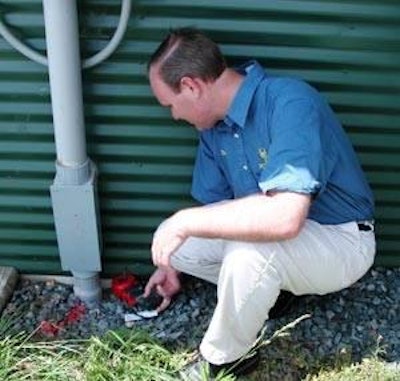
Van Wicklen said that evaluations take a day or two. Some parts of the evaluation require specialized equipment, but others can be performed with equipment that growers have.
First he checks to see whether or not the house is "tight." A tight house uses less gas to heat and less electricity to ventilate than a "loose" house. When fans are turned on in a tight house, air will be drawn in through the inlets not from gaps around doors and curtains. In cold weather, air pulled into a tight house through the vents will be drawn in along the ceiling, and it will mix with air in the middle of the house to temper the air before it hits the birds. Air drawn in through cracks around curtains and doors will sink and settle to the floor and cause condensation and can force birds away from the sides of a house. A loose house requires more timer fan time or horsepower to ventilate properly causing higher electric bills. Because of the increased ventilation required in a loose house, more gas will be burned as well.
Van Wicklen tests house tightness by closing up all of the doors, vents and curtains in the house and then turning on two 36-inch fans. He said that with the two fans on and everything closed up, the static pressure in the house should be at least 0.20 inches. But, if the static pressure is less than 0.20, look for leaks. He advises to check around doors and curtains and check to make sure that all of the vents close. Cables used to operate the vents can stretch or couplings can shift and this will let some inlets stay partially open. If the static pressure is below 0.13 inches during the closed house test, the house is very leaky. He said when checking for air leaks, be sure to check for missing or dirty fan louvers.
Van Wicklen tests the flow rate of a representative sample of the farm's fans. An apparatus, that is basically a box with wind speed indicators, is fitted over the fan. While the fan is running, the wind speed indicators send information to a laptop computer, which calculates how much air the fan is moving. Van Wicklen usually tests some of the older fans on a farm to show their relative inefficiency compared to new cone fans. In some cases, the older fans are so inefficient that electrical savings will pay for more efficient fans over time. Short of replacing fans, growers can make sure that belts aren't loose, fan shutters are clean and that there aren't any bad bearings on fan pulleys.
Van Wicklen said that the static pressure across the cooling pads shouldn't be over 0.06 inches, and if it is, then the pads are probably dirty. Dirty pads reduce water evaporation and make the fans pull against more of a load. Dirty pads can waste electricity, reduce fan life and result in a warmer house. Cleaning the pads and, if necessary, treating the water can fix the problem.
Next, water flow on the cooling pads is checked. If the pads are not thoroughly wetted, then the air inside the house won't be as cool as possible. Getting the maximum temperature drop from evaporative cooling pads can reduce the amount of time fans need to run, and the cooler temperature will improve bird performance.
Proper grounding of all electrical equipment is crucial to avoiding equipment failures that can cause bird losses. Just because your buildings electrical system is wired to a grounding rod, it doesn't mean that you have a good ground on that circuit. Van Wicklen says problems with houses not having a good ground are common. Growers should check grounding rods for all of their houses, but should pay particularly attention to the shed that houses their generator. He said that there needs to be 25 ohms or less of resistance on the grounding rod. Proper grounds are particularly important for protecting electronic equipment, like alarms, phones and controllers. It doesn't take much electricity to damage electronic equipment, even with surge protection, so check the ground on your electrical service and your phone lines.
During the house evaluations, Van Wicklen goes up into the attics of houses to inspect the insulation. He said that he has seen some older houses that have as little as two inches of insulation. Additional insulation can also be helpful in these houses and in houses where the insulation has shifted or it has been compressed after getting wet from condensation. Van Wicklen also looks for rotting wood caused by condensation.
Advances in poultry housing and equipment give growers the opportunity to provide the best environment ever for raising birds. Controlling the climate inside the broiler house takes energy, and energy costs more now than it ever has, so growers need to manage energy use wisely. Checking house tightness, inspecting insulation, fan maintenance and cleaning cooling pads can all be done without special equipment to help make sure that the dollars you are spending on energy aren't wasted.


















